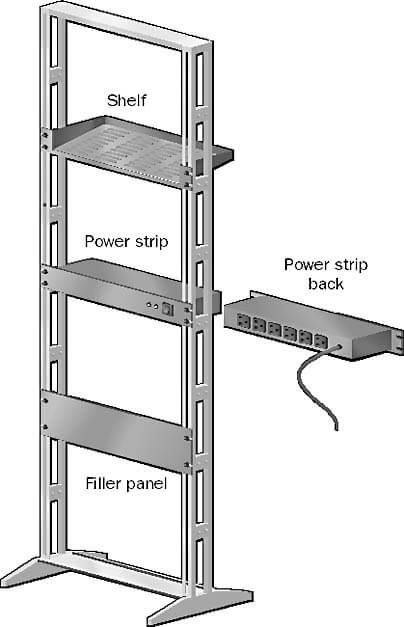In the realm of network infrastructure, efficient organization and accessibility of devices are paramount. This ultimate guide delves into the world of networking racks, essential structures designed to secure and arrange your network components systematically. From routers and switches to patch panels and UPS devices, understanding how to leverage rack-mountable solutions is key to optimizing your network’s physical layout.
Index:
- What is a Networking Rack?
- Types and Dimensions of Networking Racks
- Understanding Rack Units: The “U” Measurement
- Enhancing Rack Functionality with Accessories
- Specialized Rack Solutions
- References

1. What is a Networking Rack?
A networking rack, often referred to as an equipment rack, stands as a foundational component in the realm of network infrastructure. Crafted from durable metal, its primary role is to securely house and systematically organize a variety of networking devices. This setup is designed for ‘rack-mountable’ equipment, a category that includes essential networking tools such as hubs, routers, Ethernet switches, patch panels, and uninterruptible power supply (UPS) units. The versatility and utility of networking racks make them indispensable in creating an orderly and efficient network environment.

2. Types and Dimensions of Networking Racks
The design of networking racks caters to diverse spatial needs, offering both wall-mounted and freestanding configurations. This adaptability ensures that networking professionals can optimize their network’s physical layout regardless of space limitations. The most prevalent standard for rack width is 19 inches, a dimension that pertains to the gap between the mounting holes used to secure equipment.
It’s important to note that the overall width of a rack extends beyond this measurement, providing additional space for cable management and maintenance activities. Rack heights are commonly found in 48 and 83 inches, variations that allow for the accommodation of different volumes of networking equipment. Choosing the right type and size of rack is crucial for maximizing space efficiency and ensuring easy access to network devices.
3. Understanding Rack Units: The “U” Measurement
Adherence to EIA/TIA standards is evident in the design of networking racks, particularly in the vertical spacing of the frame holes. Spaced 1.75 inches apart, these intervals are denoted as “U” or “unit” of rack space, establishing a universal measure for equipment height within the rack. This standardization facilitates seamless integration of devices from various manufacturers, ensuring a cohesive and scalable network setup.

For example, a device labeled as 3U takes up 5.25 inches of vertical rack space, a calculation that allows network administrators to plan and optimize rack space utilization effectively. Understanding and leveraging the “U” measurement is essential for efficient rack organization and maximizing the capacity of your networking infrastructure.
4. Enhancing Rack Functionality with Accessories
The practicality of networking racks is significantly amplified through the use of accessories, which address a variety of operational challenges:
- Cable Organizers: These essential accessories mitigate the risk of cable entanglement, facilitating neat and accessible wire management. By segregating cables based on their function and destination, organizers enhance system reliability and simplify maintenance tasks.
- Sliding Shelves and Drawers: Not all networking equipment is designed with rack compatibility in mind. Sliding shelves and drawers enable the accommodation of such devices, ensuring they are securely housed within the rack and easily accessible for configuration or troubleshooting.
- Vented Sides and Fan Trays: Adequate ventilation is crucial in preventing equipment overheating. Vented rack sides and strategically placed fan trays support effective air circulation, safeguarding devices from heat-related performance degradation.
- Locking Doors: Security is a paramount concern in network management. Attaching locking doors to racks can deter unauthorized access, providing an additional layer of protection for sensitive network infrastructure.

5. Specialized Rack Solutions
Ladder Racks
Ladder racks stand out for their utility in sophisticated cable management, supporting the organized distribution of cabling across intricate network setups. By elevating cables away from foot traffic and potential interference, ladder racks ensure optimal signal integrity and system reliability.

Earthquake-Proofing
In regions prone to seismic activity, the physical security of networking equipment cannot be overlooked. Bolting racks to the floor enhances their stability, offering critical protection against the potentially devastating impacts of earthquakes on network operations.
Wall-Mounted Racks: Space-Saving Solutions
Wall-mounted racks represent an ingenious solution for optimizing space in constrained environments. By leveraging vertical space, these racks provide a secure and accessible home for networking equipment, making them an ideal choice for small offices, retail spaces, or any area where floor space is at a premium.
6. References
- Books:
- “Data Center Handbook” by Hwaiyu Geng
- “Network Infrastructure and Architecture: Designing High-Availability Networks” by Krzysztof Iniewski
- RFCs:
- Network Encyclopedia: